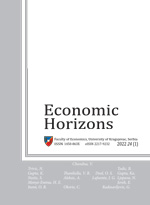THE EXPORT PERFORMANCE AND COMPETITIVENESS OF THE EURO AREA’S PERIPHERY
Radovan Kovacevic
University of Belgrade, Faculty of Economics, Belgrade, The Republic of Serbia
This paper examines the impact of the selected factors on the real exports of goods and services in the several euro area (the eurozone) peripheral economies. There are five countries in the sample (Italy, Spain, Portugal, Ireland, and Greece). The time period from 2000 to 2019 is considered. The research is aimed at providing robust estimates of the long-term relationship between the real exports of these countries and the selected explanatory variables using panel data analysis. The coefficients of the cointegration export equation were estimated using the FMOLS and DOLS estimators. Using the FMOLS estimator, the estimated coefficient of the real effective exchange rate is negative (-0.80) and of the variable foreign demand is positive (2.25). The coefficient of the real effective exchange rate confirms the fact that, from the point of view of the eurozone peripheral members, the overestimated real value of the euro has a disincentive effect on their real exports. The estimated coefficient of foreign demand suggests that the real export of goods and services (volumes) of the eurozone peripheral members increases by 2.25% when the real Gross Domestic Product (GDP) of the EU increases by 1%. The real export elasticity of the eurozone periphery countries is higher for foreign demand (income elasticity) than for relative price changes (price elasticity). Reductions in wages and prices in peripheral countries have led to redistributive effects in favor of the core.
Keywords: export, real effective exchange rate, foreign demand, net FDI inflow, cointegration, exports equation
JEL Classification: E32, F32, F41, F44




